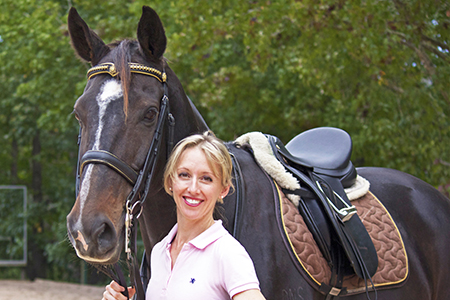 By Rebecca Ashton
By Rebecca Ashton
In this exercise, we will look at shoulder joint mobility and independent hands.
I previously described how a soft, giving hand begins with the shoulder joint, not just the elbow and wrist. Unlike the hips, the shoulder joint is very shallow allowing lots of movement but not much stability from ligaments.Therefore it needs to be supported by the shoulder cuff muscles. These muscles wrap around the joint and help create controlled movement. Too little movement in the area and the joint becomes fixed leading to an unyielding hand. Too little control and we may either jab the horse in the mouth or be unable to offer the horse a soft and constant contact. Controlled mobility of the shoulder joint allows you to keep ìgivingî the rein without throwing the contact away.
A correctly functioning shoulder joint also requires a wide chest. Sitting at a desk all day or doing a lot of other work where the body is in a hunched position can shorten the pectoralis muscles across the chest and stretch the rhomboid muscles that lie between the shoulder blades. These muscles must be balanced to create evenness in the body.
The first exercise, Dumb Waiter, helps to opens and widen the chest, brings awareness to the rhomboids and works the shoulder cuff muscles. In this exercise, I hold a theraband in both hands to add resistance. You can just as effectively do it with small weights or with no extras at all.
Good range of movement in the shoulder joint not only allows for the majority of stabilisation to instead come from the shoulder girdle, but it also allows for hands that can function independently of the body. It lightens the load on the intricate bone structure of the hand so that it can be ìcarriedî and not used to lean on the horseís mouth and balance on the reins. The second exercise will help you discover what an independent hand really feels like.
DUMB WAITER:
The Set Up:
– Find neutral spine*, standing or sitting, arms in front like you are holding a tray
– Switch off your arm muscles a little so that you can find the muscles around the shoulder joint and the rhomboids.
– On an in breath, using the lateral breathing* method, switch on your core* by imagining the low abdominals melting inwards towards your spine and lifting up gently through the pelvic floor. When breathing, imagine filling up your lungs completely, including the sides and back, not just the front. The shoulders remain relaxed and still.
Instruction Of Move:
– On an in breath, take the arms wide, tilting the hand a little so that thumb leads the movement. Keep the elbows close to your side and stretching downwards.
– Breathe out and return to start position
Visualisations:
– Hands drift apart; there is no force
– Elbows are pinned to your sides with a metal bolt
– Muscles under the armpits draw the shoulders down towards the floor
– Resist as you come back to start position.
Watch Out For:
– Elbows coming away from your sides
– Shoulders hunching or lifting up to your ears
– Hands at different levels
– Pushing the ribs to one side or the other
– Flaring ribs
– Arms doing all the work
Glossary
*Neutral Spine: This is the shape of the spine when all the vertebrae are stacked one upon the other in alignment. The spine is concave in the lower back and the neck. These natural curves allow for good shock absorption. This is what we term a neutral spine position and we want to maintain this alignment when we ride.
*Core: Your core is made up of some very deep muscles that help support your structure. They form a type of box in your lower abdomen. The top of the box is the diaphragm, the sides are formed by the internal obliques, and at the back is the multifidus which supports the vertebrae. At the front is the transversus abdominis and on the bottom is the pelvic floor. Thatís a lot of muscles to think about, so we focus mainly on the transversus and pelvic floor. Good breathing techniques will help take care of the diaphragm and correct exercise technique will support healthy obliques and multifidus. There are many ways to switch on the core, but the best way is to use imagery. Think that you are gently tightening a hipster belt, drawing up a pelvic elevator, stopping the flow of urine or melting your lower abs into your spine.
*Lateral breathing: This is style of breathing where we breathe in through the nose and out through the mouth. It helps support the core. Think of filling up the lungs without losing the engagement of the core or lifting the shoulders up. Remember to breathe into the sides and back of the lungs, not just the front. Donít forget, if youíre not used to good breathing techniques, the diaphragm and the intercostal muscles that control the rib cage will need time to learn to work properly, just like any other muscle.
 Exercise for independent hands
Exercise for independent hands
Sitting on the ball, you can take your legs wide so you are straddling the ball, like you are sitting on the horse. Hold the spine in neutral with even weight on both seat bones. With the chest and back wide, hold the arms and hands in ìriding positionî. Hold onto a stationary object, be it a broom or, as in the photo, two whips.
Keeping a well aligned ìriding positionî, gently bounce up and down on the ball keeping hold of the still whips. You will feel that the joints in the arms need to bend and soften to allow the hands to remain in the fixed spot. This is what it should feel like if your hands are still relative to the horse, instead of still relative to your own body.
